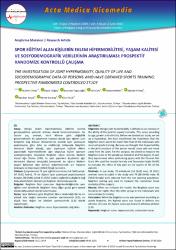| dc.contributor.author | Elmas, Muhsin | |
| dc.contributor.author | Göğüş, Başak | |
| dc.contributor.author | Topçuoğlu, Batuhan | |
| dc.contributor.author | Sav, Selin | |
| dc.contributor.author | Heybeli, Hatice | |
| dc.contributor.author | Yılmaz, Aybüke | |
| dc.contributor.author | Koçak, Batuhan | |
| dc.contributor.author | Karataş, Merve | |
| dc.contributor.author | Ocak, Yücel | |
| dc.date.accessioned | 2022-05-09T06:40:48Z | |
| dc.date.available | 2022-05-09T06:40:48Z | |
| dc.date.issued | 2020 | en_US |
| dc.identifier.citation | Elmas M. , Gogus B. , Ocak Y. Spor eğitimi alan kişilerin eklem hipermobilitesi, yaşam kalitesi ve sosyodemografik verilerinin araştırılması: prospektif randomize kontrollü çalışma. Acta Med Nicomedia. 2020; 3(2): 56-59. | en_US |
| dc.identifier.issn | 2717-8994 | |
| dc.identifier.uri | https://dergipark.org.tr/tr/pub/actamednicomedia/issue/55284/657493 | |
| dc.identifier.uri | https://hdl.handle.net/20.500.12933/939 | |
| dc.description.abstract | Amaç: Benign eklem hipermobilitesi, eklemin normal genişleyebilme yetisinin artması olarak tanımlanmaktadır. Bu durum yaş, cinsiyet, etnik kökene göre değişiklik göstermektedir. Bu çalışmanın hipotezi olarak spor eğitimi alan bireylerin bağ dokusu elemanlarının düzenli spor yapmayan popülasyona göre daha iyi olabileceği dolayısıyla Beighton skorunun düşük olacağı, spor yapmayan kişilerin eklem yapısındaki hipermobilitenin ağrı oluşturup kişileri spordan uzaklaştıracağını düşündük. Beighton skoru bakılan kişilerin Vizuel Ağrı Skalası (VAS) ile spor yaparken duydukları ağrı derecesini ölçmeyi amaçladık. Sonrasında bu ağrının kişilerin yaşam kalitesine olan etkisini değerlendirmek için Hastane Anksiyete ve Depresyon (HAD) Ölçeği kullandık.
Yöntem: Çalışmamızda 78 spor eğitimi alan birey (54 (%69) erkek, 24 (%31) kadın), 79 ise düzenli spor yapmayan popülasyondan bireyler (36 (%46) erkek 43 (%54) kadın) seçilerek bu kişilerin bağ doku elastisitesini ölçmek için Beighton skorlaması yapıldı.
Bulgular: Beighton Skor sonucunu değerlendirdiğimizde spor eğitimi alan bireylerde Beighton skoru diğer gruba göre sayısal olarak daha yüksek olarak bulunmuştur.
Sonuç: Spor dallarına göre Beighton Skoru incelendiğinde ise en yüksek skor değeri savunma sanatları sporcularında (4,5), en düşük skor değeri ise atletizm sporcularında (1,8) olarak saptanmıştır. | en_US |
| dc.description.abstract | Objective: Benign joint hypermobility is defined as an increase in the ability of the joint to expand normally. This varies according to age, gender and ethnicity. Before we started our study, we set up a hypothesis. We have established the hypothesis that the Beighton score would be lower than that of the individuals who received sports training. Because we thought that hypermobility in the joint structure of the person would cause pain and move away from the sport. For this purpose, we aimed to measure the Beighton score of the people we looked at and the degree of pain they experienced when performing sports with the Visceral Pain Scale. We used the Hospital Anxiety and Depression Scale (HADS) to evaluate the effect of this pain on the quality of life of the patients. Methods: In our study, 78 individuals (54 (%69) men, 24 (%31) women) were included in the study and 79 (38 (%46) male, 43 (%54) female) were selected from the non-sporting population. Beighton scoring was used to measure the connective tissue elasticity of the subjects. Results: When we evaluate the results, the Beighton score was found to be higher than the other group in the individuals who received sports training. Conclusion: When the Beighton score was examined according to sports branches, the highest score was found in defense arts athletes (4.5) and the lowest score was found in athletics athletes (1.8). | en_US |
| dc.language.iso | tur | en_US |
| dc.publisher | Kocaeli Üniversitesi | en_US |
| dc.rights | info:eu-repo/semantics/openAccess | en_US |
| dc.subject | Beighton skoru | en_US |
| dc.subject | hiperelastisite | en_US |
| dc.subject | Bağ doku | en_US |
| dc.title | Spor eğitimi alan kişilerin eklem hipermobilitesi, yaşam kalitesi ve sosyodemografik verilerinin araştırılması: prospektif randomize kontrollü çalışma | en_US |
| dc.title.alternative | The investigation of joint hypermobility, quality of life and sociodemographic data of persons who have obtained sports training: prospective randomized controlled study | en_US |
| dc.type | article | en_US |
| dc.authorid | 0000-0002-5626-2160 | en_US |
| dc.department | AFSÜ, Tıp Fakültesi, Dahili Tıp Bilimleri Bölümü, Tıbbi Genetik Ana Bilim Dalı | en_US |
| dc.contributor.institutionauthor | Elmas, Muhsin | |
| dc.contributor.institutionauthor | Göğüş, Başak | |
| dc.contributor.institutionauthor | Topçuoğlu, Batuhan | |
| dc.contributor.institutionauthor | Sav, Selin | |
| dc.contributor.institutionauthor | Heybeli, Hatice | |
| dc.contributor.institutionauthor | Yılmaz, Aybüke | |
| dc.contributor.institutionauthor | Koçak, Batuhan | |
| dc.contributor.institutionauthor | Karataş, Merve | |
| dc.identifier.volume | 3 | en_US |
| dc.identifier.issue | 2 | en_US |
| dc.identifier.startpage | 56 | en_US |
| dc.identifier.endpage | 59 | en_US |
| dc.relation.journal | Acta Med Nicomedia | en_US |
| dc.relation.publicationcategory | Makale - Ulusal Hakemli Dergi - Kurum Öğretim Elemanı | en_US |
















